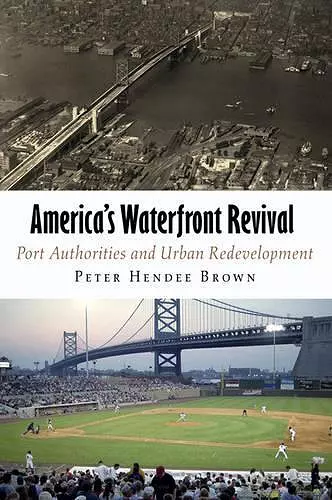America's Waterfront Revival
Port Authorities and Urban Redevelopment
Format:Hardback
Publisher:University of Pennsylvania Press
Published:6th Jan '09
Currently unavailable, and unfortunately no date known when it will be back

Examines the experiences of the port authorities of Tampa, San Francisco, San Diego, and Philadelphia and Camden, organizations that diversified beyond traditional maritime cargo operations into new lines of business related to waterfront development.
Since the early years of the twentieth century, public authorities have been providing an enormous share of the public infrastructure in the United States and have shaped our urban environment in powerful ways. Politicians have continued to create new public authorities, but many older ones remain influential, adapting to ever-changing economic trends, technologies, and user demands by entering new lines of business. Among the authorities that have continued to change and have remained relevant are many of the nation's industrial-era port authorities, including the Tampa Port Authority, the Port of San Francisco, the Port of San Diego, and the Delaware River Port Authority.
Despite their unique histories, markets, and geographic locations, these four ports have many similarities. Most important, as globalization and technological change led to declines in shipping, they all evolved from single-purpose maritime cargo-handling operations into diversified business organizations focused on waterfront revitalization. All four ports became deeply involved in real estate development in support of nontraditional maritime and nonmaritime public and commercial uses.
In America's Waterfront Revival, Peter Hendee Brown examines the experiences of these four port authorities, considering three important questions. First, how did external and internal forces encourage or impede these authorities as they engaged in new functions? How did the port authorities transform themselves as organizations in order to implement waterfront redevelopment? Do public authorities change as institutions when they diversify into new functional areas and, if so, do abstract theoretical models of public authorities adequately account for this institutional evolution?
Drawing on a wide range of sources, including enabling legislation, annual reports, financial statements, strategic business plans, land use plans, audits, media accounts, and interviews, this book delivers significant new findings on the opportunities and challenges existing authorities face when they engage in new functions.
"Highly recommended." * Choice *
"This is really a very impressive book-accessible, thorough, deep, and compelling. Brown's research and insights should prove very useful to anyone interested in advancing complex urban projects." * James Corner, Founder and Director, James Corner Field Operations *
"Peter Brown's America's Waterfront Revival offers an engaging and in-depth look at four very different waterfronts, showing the difficulties and rewards of redeveloping our urban waterfronts. Such places offer an exceptional insight into the sometimes-jarring changes that come with the transformation of the American economy from industrial production to service-oriented consumption, which has altered our relationship to water and the natural environment at the same time. There is much to learn in this insightful book." * Thomas Fisher, University of Minnesota *
"An accessible and fascinating account of the expanding impact of U.S. port authorities on the urban fabric. Lively prose, excellent maps, and high quality photographs make this a book an enjoyable, as well as informative, read." * Gail Radford, author of Modern Housing for America: Policy Struggles in the New Deal Era *
"America's Waterfront Revival is a fascinating account of the evolving role of port authorities in the United States. He has captured the dynamic tensions inherent in the transition of these authorities from managing port facilities to playing large roles in economic development and infrastructure improvement projects. His account is balanced and fair, but does not shy away from some of the hard questions and issues that the authorities face in their new roles-how far should economic development activities reach and to what types of projects; how should different states cooperate to enhance regional development; how do port authorities coordinate with local, state and federal decision makers in setting strategic direction; and how do political forces shape the decision making process of port authority boards and senior staff. In an era in which we are again focused on infrastructure needs, this is a must read for those interested in the future role of port authorities." * John H. Estey, Chairman, Board of Commissioners, Delaware River Port Authority *
ISBN: 9780812241228
Dimensions: unknown
Weight: unknown
240 pages